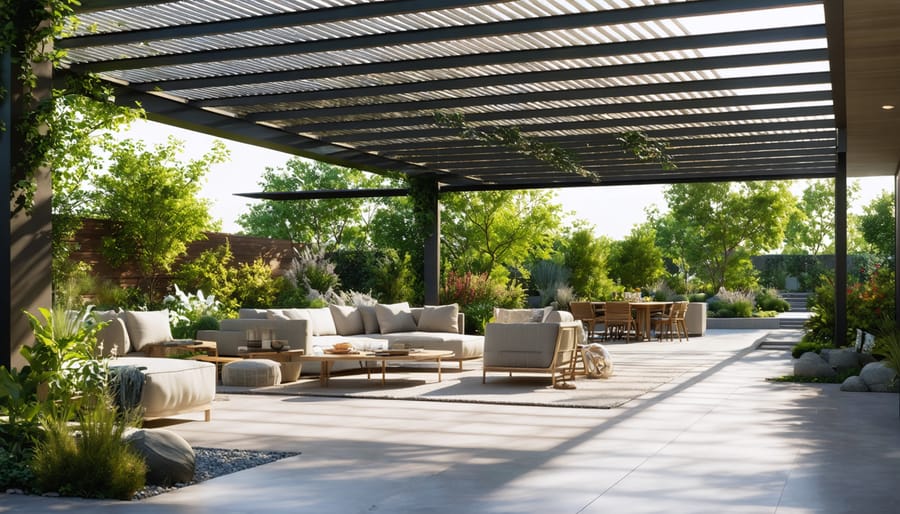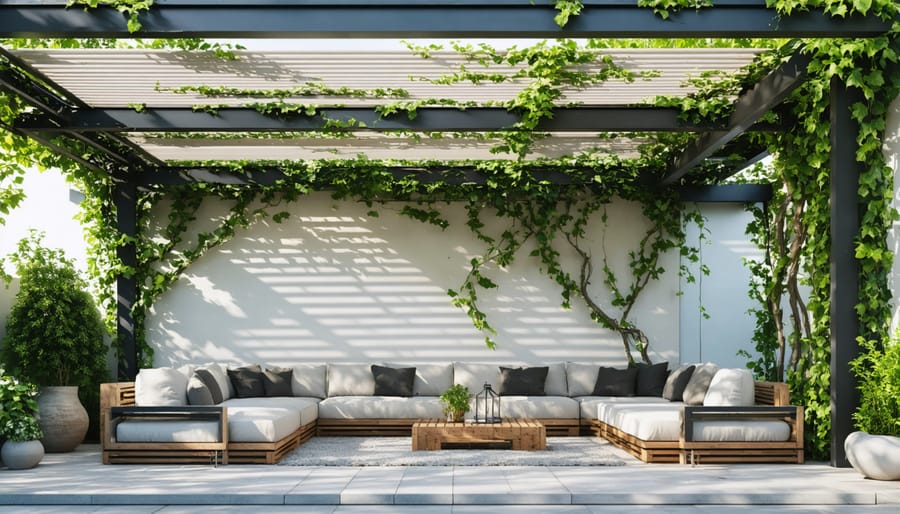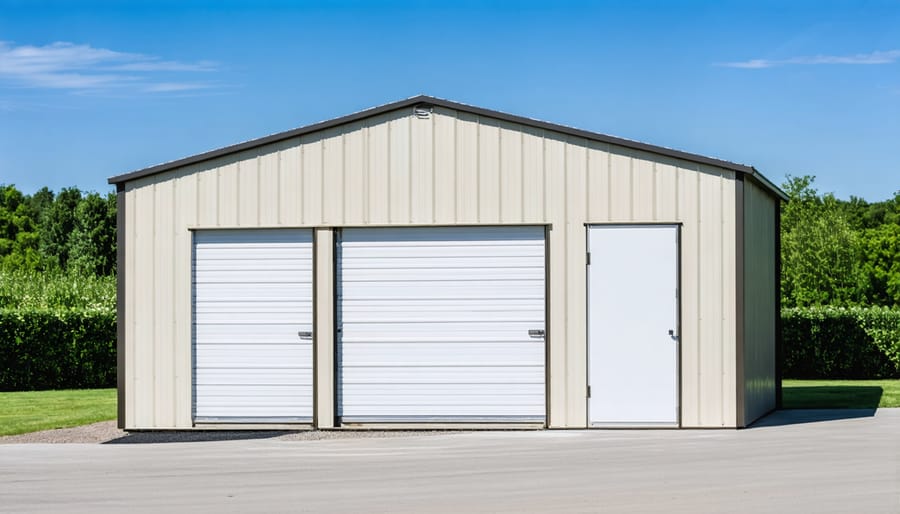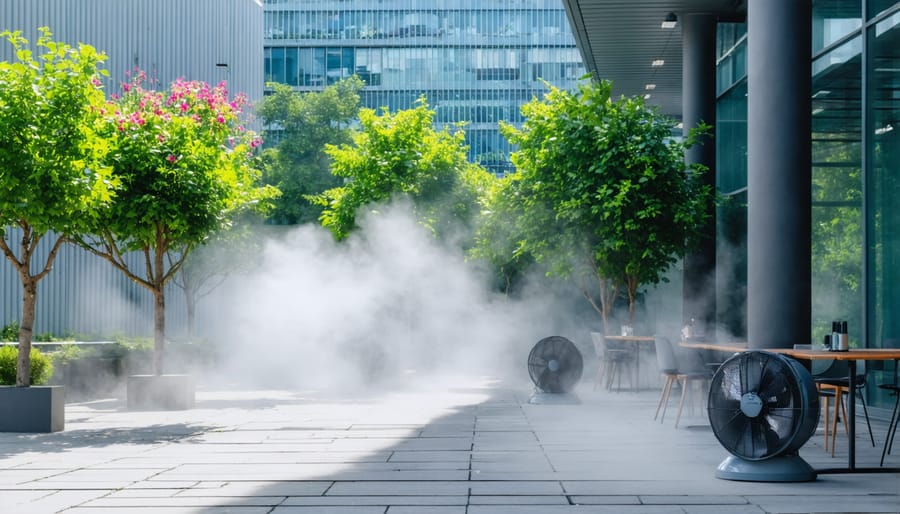Transform Your Outdoor Workspace: Smart Heat Protection That Really Works

Transform your outdoor living and working spaces to thrive in rising temperatures through smart adaptation strategies. Creating a comfortable outdoor workspace design starts with installing adjustable shade structures like retractable awnings or pergolas with movable canvas panels. Install high-efficiency cooling systems, including misting devices and outdoor ceiling fans, to maintain productivity during heat waves. Strategic landscaping with native, drought-resistant plants and trees provides natural cooling while reducing water consumption. Implement water-smart solutions like rainwater harvesting systems and permeable surfaces to manage increasing rainfall intensity and prevent flooding. These practical adaptations not only protect your property investment but also create resilient outdoor spaces that remain functional regardless of climate challenges. By taking action now, homeowners can maintain comfortable, usable outdoor areas while contributing to sustainable climate solutions.
Heat-Smart Shade Solutions for Your Outdoor Space
Permanent vs. Portable Shade Structures
When it comes to creating cool outdoor spaces, homeowners have several excellent options to choose from. Permanent structures like gazebos and pergolas offer lasting protection and can become attractive focal points in your yard. Gazebos provide complete overhead coverage and can reduce temperatures by up to 15 degrees, while pergolas with retractable canopies combine architectural appeal with flexible shade control.
For those seeking versatility, retractable awnings present an adaptable solution that can be extended during peak sun hours and retracted when more natural light is desired. These structures typically reduce heat gain by 65-77% on windows and can be motorized for easy operation.
When choosing between permanent and portable options, consider factors like your local climate, property layout, and desired aesthetic. Permanent structures generally offer more robust protection and can withstand various weather conditions, while portable solutions provide flexibility and often come at a lower cost point.
For maximum effectiveness, combine your chosen shade structure with heat-resistant materials and strategic landscaping to create a consistently comfortable outdoor environment. Many homeowners find that mixing different shade solutions provides the best coverage throughout the day as the sun moves across their property.

Natural Cooling with Strategic Greenery
Strategic planting can transform your outdoor space into a naturally cooler environment while creating sustainable outdoor workspace solutions. Start by planting deciduous trees on the south and west sides of your structures to provide shade during summer while allowing warming sunlight in winter. Fast-growing vines like Virginia creeper or climbing hydrangea can create living walls that absorb heat and reduce ambient temperatures by up to 5°F.
Consider installing trellises or pergolas near windows and doorways, then train climbing plants to create natural curtains. These green barriers not only provide shade but also release moisture through transpiration, creating a natural cooling effect. Native plants are particularly effective as they’re already adapted to local conditions and require less maintenance.
For immediate results, position large potted plants strategically around your outdoor workspace. Container gardens with trailing plants can provide portable shade solutions while adding visual appeal. Remember to group plants together to create humidity pockets and maximize their cooling benefits.
Weather-Ready Storage Solutions
Ventilation Systems That Beat the Heat
As temperatures rise, keeping your storage shed or workspace comfortable becomes crucial. Smart ventilation solutions can make a world of difference in maintaining a pleasant environment while protecting your stored items from heat damage and moisture buildup.
Start with passive ventilation by installing ridge vents along your roof’s peak and soffit vents under the eaves. This natural airflow system creates a “chimney effect,” drawing cool air in from below while pushing hot air out through the top. For existing structures, adding gable vents on opposite walls can create effective cross-ventilation without major modifications.
Solar-powered fans offer an eco-friendly boost to your ventilation system. These self-sufficient units kick in when temperatures rise, requiring no electrical work or ongoing energy costs. Many models come with built-in thermostats, automatically adjusting to maintain your ideal temperature range.
Consider installing adjustable window vents or louvered openings that can be controlled based on weather conditions. These allow you to fine-tune airflow while keeping rain and debris out. For additional cooling power, combine these with reflective roof coating or radiant barriers to reduce heat absorption.
“My workshop used to be unbearable during summer afternoons,” shares Mike Thompson, a woodworking enthusiast. “After installing a solar fan and gable vents, the temperature difference is remarkable. I can now work comfortably even during peak heat hours.”

Temperature-Resistant Materials
In response to rising temperatures, choosing the right weather-resistant materials for your outdoor structures has become more crucial than ever. Modern engineered vinyl and high-grade composites lead the pack in heat resistance, offering excellent durability while maintaining their appearance even in extreme temperatures. These materials typically withstand temperatures up to 140°F (60°C) without warping or degrading.
Metal structures, particularly those made from galvanized steel with specialized heat-reflective coatings, provide outstanding heat resistance and longevity. When properly treated, these materials can reflect up to 80% of solar radiation, helping maintain cooler interior temperatures.
For roofing, cool-roof materials like thermoplastic polyolefin (TPO) or modified rubber compounds offer superior heat reflection. These materials can reduce surface temperatures by up to 50°F compared to traditional roofing materials, making them ideal for hot climates.
Natural materials like cedar and treated hardwoods continue to be excellent choices, especially when sealed with UV-resistant finishes. Their natural thermal properties help regulate temperature while providing classic aesthetic appeal.
Consider incorporating reflective insulation materials like radiant barriers in walls and roofs. These materials can block up to 97% of radiant heat, significantly improving comfort levels inside outdoor structures during hot weather.
Quick-Install Cooling Solutions
Misting Systems and Fans
Misting systems and fans offer effective solutions for cooling outdoor spaces during intense heat waves. A well-designed misting system can lower ambient temperatures by up to 20 degrees Fahrenheit while using minimal water. These systems work by releasing a fine spray of water that quickly evaporates, creating a cooling effect perfect for patios, workshops, and outdoor seating areas.
For optimal results, consider installing high-pressure misting systems with stainless steel nozzles, which create ultra-fine water droplets that evaporate before settling on surfaces. Many homeowners combine these with sturdy outdoor ceiling fans to enhance air circulation and maximize cooling efficiency.
Portable misting fans provide a flexible alternative, allowing you to move cooling where it’s needed most. These units are particularly useful in workshop environments or temporary outdoor workspaces. When selecting a misting system, look for models with adjustable settings and automatic shut-off features to conserve water and energy.
Installation tip: Position misting lines around the perimeter of your outdoor space, approximately 8-10 feet high, and angle nozzles slightly downward. This setup ensures even coverage while preventing excess moisture on furniture or work surfaces. Regular maintenance, including cleaning nozzles and checking for leaks, will keep your system running efficiently throughout the hot season.

Heat-Reflective Treatments
Heat-reflective treatments offer an effective way to combat rising temperatures in outdoor structures and living spaces. These innovative solutions work by reflecting solar radiation rather than absorbing it, significantly reducing heat buildup. Popular options include cool-roof coatings, which can be applied to existing roofs and typically contain reflective pigments that bounce sunlight away from the surface.
For walls and exterior surfaces, specialized reflective paints containing ceramic microspheres or infrared-reflecting pigments can decrease surface temperatures by up to 30%. These coatings are particularly effective when applied in light colors, with white being the most reflective option. Many homeowners are now choosing heat-reflective window films, which can block up to 80% of solar heat while still allowing natural light to enter.
Recent innovations include thermochromic treatments that automatically adjust their reflective properties based on temperature changes. These smart coatings become more reflective as temperatures rise, providing dynamic temperature control throughout the day. For best results, combine these treatments with proper insulation and ventilation strategies.
When selecting heat-reflective treatments, consider factors such as durability, maintenance requirements, and local climate conditions. Many of these solutions are DIY-friendly and can be applied during a weekend project, making them an accessible option for most homeowners.
Maintenance Tips for Climate-Adapted Spaces
Regular maintenance is key to ensuring your climate-adapted spaces remain effective and durable throughout the year. Start by inspecting your shade structures and cooling solutions monthly, checking for any wear and tear, loose components, or damage from weather exposure.
For green solutions like climbing plants and living walls, maintain a consistent watering schedule and trim back overgrowth regularly. During spring, assess your irrigation systems and repair any damaged components before the heat of summer arrives. Clean and maintain misting systems to prevent mineral buildup and ensure optimal performance.
Check weatherstripping and seals around doors and windows seasonally to maintain cooling efficiency. Clean reflective surfaces and light-colored materials twice yearly to maintain their heat-reflecting properties. For passive cooling elements like ventilation systems, clear any debris and clean filters monthly.
Natural shade solutions require particular attention during changing seasons. Trim trees and bushes before winter to prevent storm damage, and again in spring to optimize shade coverage. For water features, clean regularly and check pump systems monthly to prevent algae growth and ensure proper circulation.
Document all maintenance activities and set calendar reminders for regular checks. This proactive approach helps identify potential issues before they become major problems and extends the lifespan of your climate adaptation investments. Remember to adjust your maintenance schedule based on local weather patterns and seasonal changes.
As our climate continues to change, adapting our outdoor spaces and storage solutions becomes increasingly important. By implementing shade structures, proper ventilation, and heat-resistant materials, we can create more comfortable and sustainable environments that withstand rising temperatures. Whether you choose to install a well-insulated shed, add reflective roofing, or incorporate natural cooling methods, every step toward climate adaptation matters. Remember that these improvements not only protect your belongings and create more comfortable workspaces but also contribute to the broader effort of climate resilience. Start with small changes today, and gradually build up to larger adaptations as needed. Together, we can create smarter, more sustainable storage solutions that stand up to tomorrow’s challenges while maintaining the functionality and appeal of our outdoor spaces.

